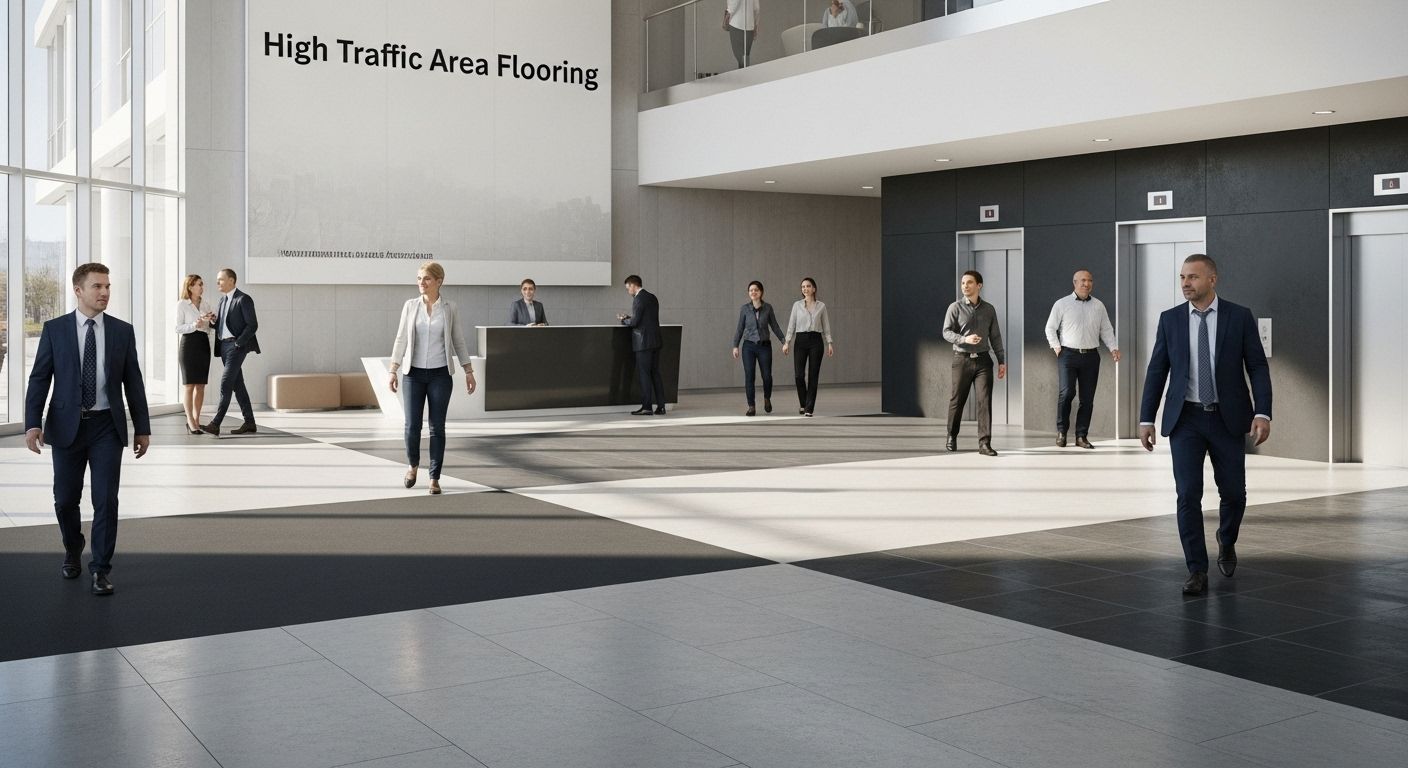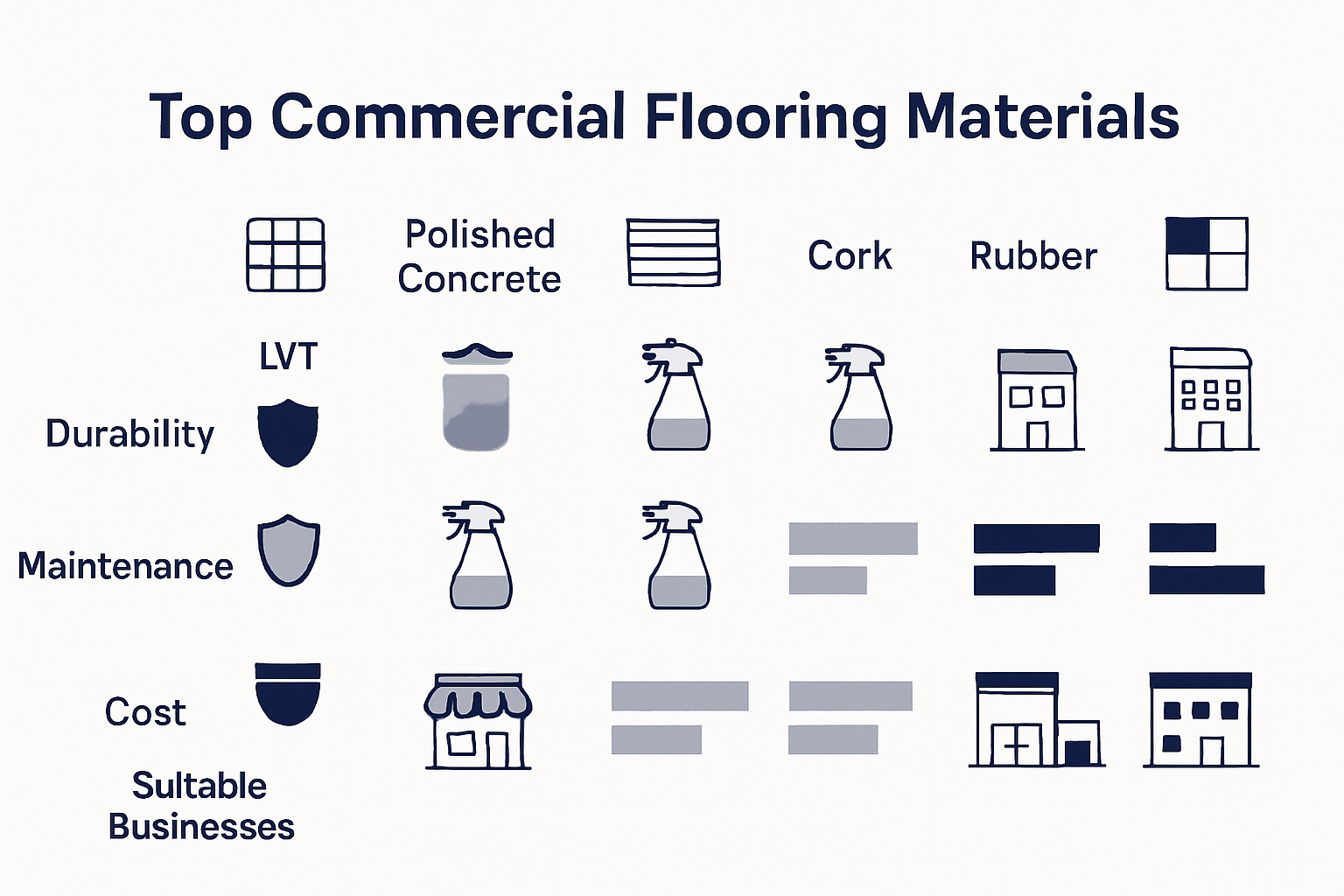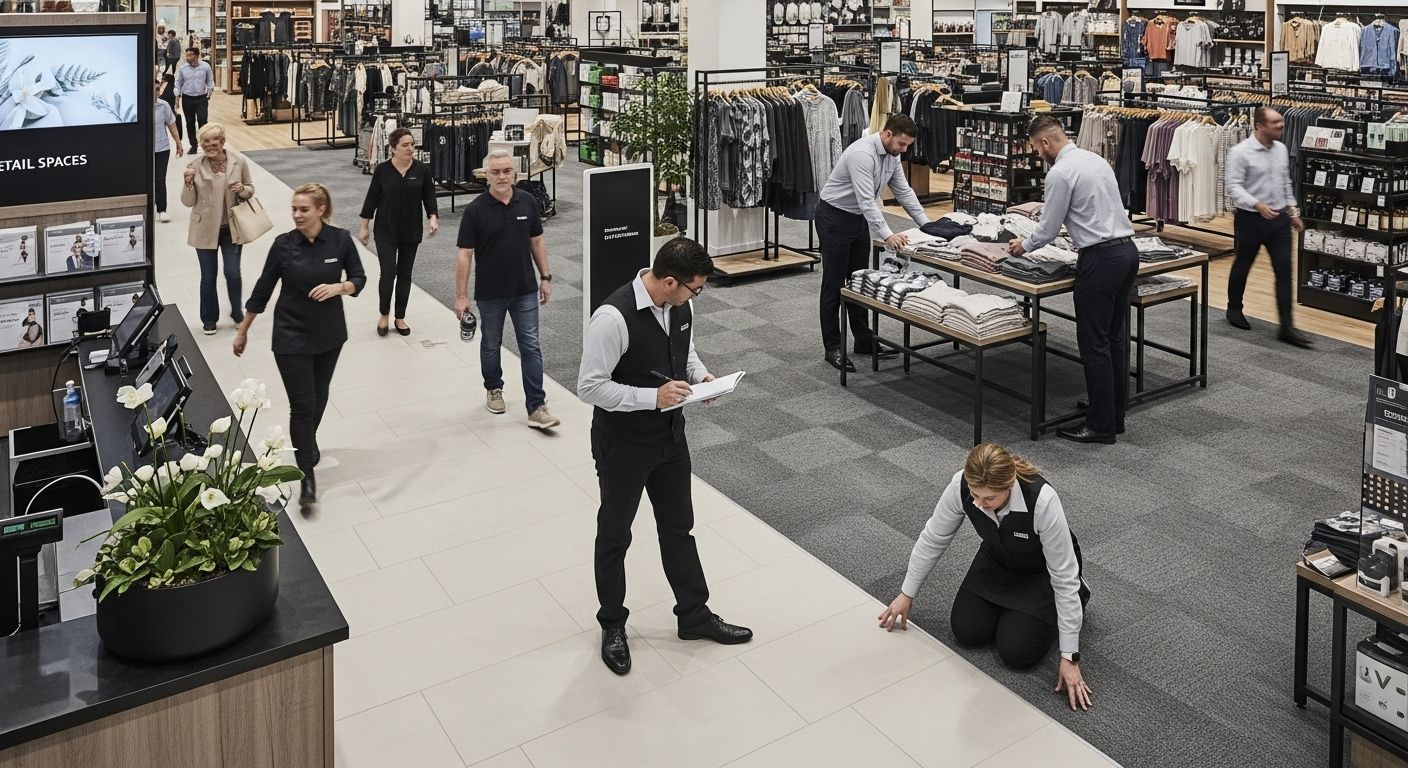
Flooring can make or break a business space. Some commercial floors survive over 50,000 footsteps a day without showing a scratch. You might think good looks are what matter most, but durability and safety in high traffic areas actually outsmart grand designs every time. Discover why your flooring choice is more about lasting performance than flashy finishes.
Table of Contents
- What To Look For In High Traffic Area Flooring
- Top Flooring Materials For Busy Spaces
- Maintenance Tips To Extend Flooring Lifespan
- Choosing The Right Flooring For Your Industry
Quick Summary
| Takeaway | Explanation |
|---|---|
| Choose durable materials for high traffic areas | Opt for rubber, vinyl, or porcelain tile to ensure longevity under heavy use. |
| Prioritize safety features in flooring | Implement slip-resistant surfaces to enhance safety in wet or busy areas. |
| Consider long-term maintenance costs | Select flooring that requires minimal upkeep, reducing future expenses. |
| Evaluate industry-specific flooring needs | Each sector, like healthcare or retail, has unique requirements for flooring performance. |
| Utilize effective cleaning strategies | Regular dust mopping and entrance mats help to preserve flooring quality over time. |
What to Look for in High Traffic Area Flooring
Selecting the right flooring for high traffic areas requires careful consideration of multiple critical factors that go beyond simple aesthetic appeal. Businesses must prioritize performance, durability, and long-term value when making flooring decisions that will impact their operational efficiency and safety.
Durability and Wear Resistance
In high traffic environments, flooring must withstand constant movement, heavy loads, and repetitive stress. According to industry research, materials like rubber, vinyl, and porcelain tile demonstrate exceptional resilience in commercial settings. These materials can resist significant wear and maintain their structural integrity even under intense daily use.
Businesses should evaluate flooring options based on their specific traffic patterns. Entryways, corridors, and customer service areas typically experience the most foot traffic and require materials with superior wear resistance. Rubber flooring, for instance, offers remarkable durability and can absorb impact while maintaining its shape and appearance over extended periods.
Safety and Performance Considerations
Research on commercial spaces highlights the importance of selecting flooring that balances safety with performance. Slip resistance becomes paramount in areas prone to moisture or frequent movement. Materials with textured surfaces or integrated slip-resistant properties can significantly reduce workplace accidents.
Acoustic properties also play a crucial role in high traffic area flooring. Certain vinyl and rubber materials can help dampen sound, creating a more comfortable and productive environment. This is particularly important in open-plan offices, retail spaces, and educational institutions where noise reduction contributes to overall user experience.
Maintenance and Long-Term Cost Efficiency
Beyond initial installation, businesses must consider the long-term maintenance requirements of their flooring. High-quality materials that require minimal upkeep can provide substantial cost savings over time. Cleaning and maintenance experts recommend selecting flooring that can be easily cleaned and does not require specialized treatment or frequent replacement.
By carefully evaluating these key factors, businesses can select high traffic area flooring that not only meets their immediate aesthetic and functional needs but also provides sustainable, long-lasting performance. Learn more about workplace safety solutions that can complement your flooring choices and create a more secure environment.
Top Flooring Materials for Busy Spaces
Choosing the right flooring material for high-traffic spaces is crucial for businesses seeking durability, performance, and aesthetic appeal. Different environments demand specialized flooring solutions that can withstand constant use while maintaining their visual integrity and functional characteristics.
Commercial-Grade Resilient Flooring Options
Commercial flooring experts recommend several robust materials designed specifically for demanding environments. Luxury vinyl tile (LVT) stands out as a premier choice, offering exceptional durability and versatility. This material provides remarkable resistance to wear, moisture, and heavy foot traffic while presenting a wide range of design possibilities.
Polished concrete represents another outstanding option for busy spaces. Known for its incredible strength and low maintenance requirements, polished concrete can transform industrial environments into sleek, modern settings. Its seamless surface minimizes dirt accumulation and provides excellent long-term performance in areas experiencing significant daily movement.
Sustainable and Eco-Friendly Alternatives
Research on sustainable flooring reveals innovative materials that balance environmental responsibility with high-performance characteristics. Bamboo and cork emerge as compelling alternatives, offering unique properties that make them suitable for commercial applications. Bamboo flooring delivers remarkable durability and rapid renewability, growing significantly faster than traditional hardwood materials.
Linoleum and marmoleum present eco-conscious options that do not compromise on performance. These natural materials are composed of renewable resources like linseed oil, cork dust, and wood flour, providing excellent wear resistance while maintaining a minimal environmental footprint. Their inherent antimicrobial properties make them particularly attractive for healthcare, educational, and retail environments.
Advanced Performance Flooring Solutions
Detailed commercial flooring analysis highlights advanced materials engineered for extreme durability. Rubber flooring stands out as a superior choice for areas requiring shock absorption and noise reduction. Its resilient nature makes it ideal for gymnasiums, manufacturing facilities, and spaces with heavy equipment or constant movement.
Commercial carpet tiles offer another sophisticated solution, providing modular flexibility and ease of maintenance. These tiles can be individually replaced when damaged, reducing long-term replacement costs. Their ability to dampen sound and provide aesthetic variety makes them popular in office spaces, educational institutions, and hospitality environments.
By carefully evaluating these materials and their specific performance characteristics, businesses can select flooring solutions that not only meet their functional requirements but also enhance the overall aesthetic and operational efficiency of their spaces. Explore our workplace safety solutions to complement your flooring choices and create a more secure environment.
To help you compare popular high traffic flooring materials, the table below summarizes their key properties, benefits, and suitable uses as discussed in the article.
| Flooring Material | Key Benefits | Ideal Environments |
|---|---|---|
| Rubber | Exceptional durability, slip-resistant, noise reduction | Gyms, manufacturing, industrial |
| Luxury Vinyl Tile (LVT) | Wear/moisture resistance, design versatility | Retail, hospitality, offices |
| Porcelain Tile | High wear resistance, easy upkeep | Entrances, corridors, high-traffic |
| Polished Concrete | Strength, low maintenance, seamless surface | Industrial, modern commercial |
| Bamboo | Sustainable, durable, quick renewability | Eco-conscious, retail, offices |
| Cork | Eco-friendly, antimicrobial, sound absorption | Educational, healthcare, offices |
| Linoleum/Marmoleum | Renewable, antimicrobial, wear-resistant | Healthcare, education, retail |
| Carpet Tiles | Modular, sound dampening, easy replacement | Offices, hospitality, education |

Maintenance Tips to Extend Flooring Lifespan
Proper maintenance is critical for preserving the performance, appearance, and longevity of high-traffic area flooring. Businesses can significantly reduce replacement costs and maintain a professional environment by implementing strategic care and cleaning protocols tailored to their specific flooring materials.
Daily and Routine Cleaning Strategies
Research from Rutgers Cooperative Extension emphasizes the importance of consistent, preventative maintenance for resilient floor coverings. Dust mopping emerges as a fundamental first line of defense against premature wear. Frequent removal of grit, dirt, and particulate matter prevents these abrasive materials from scratching and degrading floor surfaces.
Implementing comprehensive entrance mat systems can dramatically reduce the volume of dirt tracked into high-traffic areas. These strategic mat placements capture dirt, moisture, and debris before they can damage flooring materials. Businesses should consider multi-zone matting solutions that include scraper mats, moisture-absorbing intermediate mats, and final interior mats to maximize floor protection.
Specialized Cleaning Techniques
Different flooring materials require nuanced cleaning approaches. Vinyl and luxury vinyl tile benefit from pH-neutral cleaning solutions that remove dirt without causing chemical degradation. Avoid harsh chemicals or abrasive cleaning tools that can strip protective coatings or create microscopic surface damage.
For hard surfaces like polished concrete or tile, regular wet cleaning using microfiber mops provides thorough cleaning without excessive moisture. Professionals recommend using clean water and approved cleaning solutions, changing mop water frequently to prevent redepositing dirt. Automated floor scrubbers can offer efficient deep cleaning for large commercial spaces, ensuring consistent maintenance across extensive floor areas.
Preventative Maintenance and Protection
Protective strategies play a crucial role in extending flooring lifespan. Implementing furniture pads on chair and table legs prevents scratching and indentation in soft flooring materials. Regular floor inspections can identify potential issues like small tears, loose tiles, or developing wear patterns before they become significant problems.
Controlling environmental factors also contributes to floor longevity. Maintaining consistent humidity levels, protecting floors from direct sunlight, and managing temperature fluctuations can prevent material expansion, contraction, and degradation. For areas with extreme environmental conditions, consider additional protective treatments or specialized floor coatings.
By adopting a comprehensive, proactive approach to floor maintenance, businesses can substantially extend the useful life of their flooring investments. Learn more about workplace safety and maintenance solutions that can help protect your commercial spaces and optimize floor performance.
Below is a checklist-style table to guide your daily and periodic flooring maintenance routines, summarizing best practices and preventative actions described in the article.
| Maintenance Task | Frequency | Purpose |
|---|---|---|
| Dust mopping | Daily | Remove dirt, prevent abrasions/wear |
| Use entrance mats (multi-zone) | Ongoing | Trap dirt/moisture before floor contact |
| Wet cleaning with pH-neutral agents | Weekly/As needed | Deep clean, avoid chemical damage |
| Inspect for damage (tears, loose tiles) | Monthly | Catch issues early, address repairs |
| Apply furniture pads | As needed | Prevent scratches/indentations |
| Control temperature/humidity | Ongoing | Reduce expansion, contraction, degradation |
| Professional deep cleaning | Periodic | Maintain appearance/performance |
Choosing the Right Flooring for Your Industry
Selecting appropriate flooring requires a nuanced understanding of industry-specific demands and performance requirements. Each commercial sector presents unique challenges that necessitate tailored flooring solutions designed to optimize safety, durability, and operational efficiency.
Healthcare and Medical Facilities
According to the Whole Building Design Guide, healthcare environments demand flooring materials that prioritize hygiene, infection control, and easy maintenance. Seamless epoxy or sheet vinyl flooring emerge as top choices, offering smooth surfaces that minimize bacterial growth and facilitate thorough cleaning. These materials must withstand frequent chemical disinfection, heavy medical equipment movement, and constant foot traffic from staff and patients.
Specialized healthcare flooring should incorporate antimicrobial properties and resist moisture penetration. Color and pattern selections can also contribute to wayfinding and reducing visual fatigue for medical staff, demonstrating how flooring goes beyond mere functional requirements.
Manufacturing and Industrial Environments
Occupational safety research highlights critical flooring considerations for industrial spaces. Rubber and epoxy flooring provide exceptional durability and shock absorption in environments with heavy machinery, potential chemical exposures, and significant mechanical stress. These materials offer superior resistance to impacts, chemical spills, and temperature fluctuations.
Additionally, industrial flooring must address worker safety through integrated slip-resistant textures and high-visibility markings. Considerations like electrical conductivity, fire resistance, and ease of decontamination become paramount in specialized manufacturing settings such as electronics production, pharmaceutical laboratories, and chemical processing facilities.
Retail and Hospitality Spaces
Retail and hospitality environments require flooring that balances aesthetic appeal with robust performance. Luxury vinyl tile (LVT) and commercial-grade carpet tiles offer design flexibility while maintaining high durability standards. These materials can withstand constant customer traffic, provide sound absorption, and create welcoming visual environments.
In retail spaces, flooring should accommodate frequent layout changes, support heavy display structures, and resist staining and wear. Hospitality settings demand materials that can transition seamlessly between different zones like lobbies, conference areas, and dining spaces, maintaining a cohesive and professional appearance.

By carefully analyzing industry-specific requirements, businesses can select flooring solutions that not only meet functional needs but also enhance operational efficiency and workplace experience. Learn more about creating safer workplace environments through strategic flooring choices that protect both assets and personnel.
Frequently Asked Questions
What factors should I consider when choosing flooring for high traffic areas?
When selecting flooring for high traffic areas, prioritize durability and wear resistance, safety features like slip resistance, maintenance requirements, and long-term cost efficiency. Evaluate your industry’s specific needs as well, as different sectors have unique demands.
What are the best flooring materials for commercial environments?
For commercial environments, materials such as rubber, luxury vinyl tile (LVT), porcelain tile, and polished concrete are highly recommended due to their durability, ease of maintenance, and resistance to wear and moisture.
How can I maintain high traffic flooring to extend its lifespan?
To extend the lifespan of high traffic flooring, implement daily dust mopping, utilize entrance mats to reduce dirt and moisture, conduct regular wet cleaning with appropriate solutions, and perform monthly inspections for damage. Consider professional deep cleaning periodically for optimal maintenance.
Why is slip resistance important in high traffic flooring?
Slip resistance is crucial in high traffic flooring because it helps to prevent accidents and injuries in areas prone to moisture or heavy foot traffic. Textured surfaces or materials with integrated slip-resistant properties can greatly enhance safety in commercial spaces.
Upgrade Your High Traffic Flooring With Reliable Mats
Heavy foot traffic can quickly wear down even the toughest flooring, leading to higher costs, safety concerns, and a less professional look for your business. If you want to protect your flooring investment and maximize durability, the right mat solutions are the key. Custom mats provide unmatched wear resistance and support daily maintenance by blocking dirt and moisture before they become a problem. Whether you manage a busy retail shop, an industrial entryway, or want to elevate your branding, choosing quality mats helps you meet every goal outlined in the article: performance, longevity, safety, and cost efficiency.
Explore our selection of Waterhog Logo Mats designed to handle the challenges of high-traffic areas while showcasing your company’s image. Or browse All Logo Mats for more options that blend style and protection. Ready to make a smart flooring decision for your business? Visit Mats4U.com to find the perfect solution and order today for long-term savings and peace of mind.







